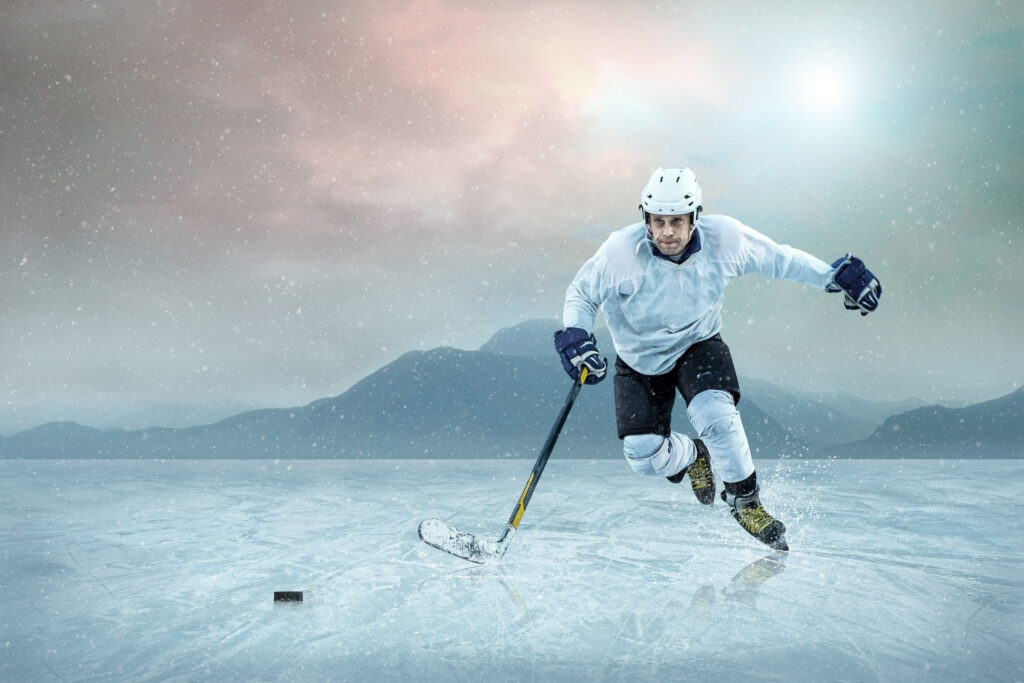PART I – INTRODUCTION
Winter is quickly approaching and with it comes my favorite time of year, ice hockey season!
Ice hockey is known for its high speed, hard hits, and agility to turn on a blade 1/8th of an inch thick; but today we are going to discuss a lesser-known part of the game…the “groin” injury.
The Groin Strain
For the purposes of this article, we will refer to the groin as the muscles that cross the front and inside of the hip, known as the hip flexors and hip adductors.
The groin, like all muscles, can have varying degrees of “strain” that can be broken down into 1. Light pull, 2. Partial tear, and 3. Full rupture.
The main causes of a groin strain in ice hockey are from over striding (your leg extended too far behind you) and or having your leg pulled out from under you by another player’s skate or stick.
However, it is important to note that having an excess curve of the low back and forward tilt of the pelvis (which hockey players can develop) can also cause a groin injury because that posture leads to short and stiff groin muscles that are easily overstretched.
To Stretch or Not to Stretch
Now that you’ve learned how a groin strain can occur, it seems like all you would have to do to prevent one is stretch, right?…not quite.
With an abundance of research on injury prevention, there have been no high-quality studies that show stretching actually prevents injuries.
The only treatment that has been shown to actually cause a muscle to get longer while also getting stronger is the use of eccentric contractions.
An eccentric muscle contraction occurs when a muscle is actively creating tension while increasing in length… an easy visual would be the lowering portion of a bicep curl. These contractions are commonly known in fitness gyms as “negatives”.
Getting Long and Strong
Eccentrics are an important part of an injury prevention or rehabilitation program because most muscle strains do NOT occur from being inflexible (contrary to popular belief), but more often because of a lack of strength in a lengthened position.
Stay tuned for Part II where we will take a look at how to achieve proper core stability before progressing to groin mobility and strength
Now that you’ve learned how a groin strain can occur, it seems like all you would have to do to prevent one is stretch, right?… not quite.
With an abundance of research on injury prevention, there have been no high-quality studies that show stretching actually prevents injuries.
The only treatment that has been shown to actually cause a muscle to get longer while also getting stronger is the use of eccentric contractions.
An eccentric muscle contraction occurs when a muscle is actively creating tension while increasing in length… an easy visual would be the lowering portion of a bicep curl. These contractions are commonly known in fitness gyms as “negatives”.
Getting Long and Strong
Eccentrics are an important part of an injury prevention or rehabilitation program because most muscle strains do NOT occur from being inflexible (contrary to popular belief), but more often because of a lack of strength in a lengthened position.
Stay tuned for Part II where we will take a look at how to achieve proper core stability before progressing to groin mobility and strength.
Find us fast using our text-to-locate feature by texting your zip code to 1-844-700-0013 or visit our locations page on our website at www.sportscare1.com/locations
We also now offer RecoveryCare at our clinics in SportsCare Arena (Randolph, NJ) and Skylands Ice World (Stockholm, NJ).


